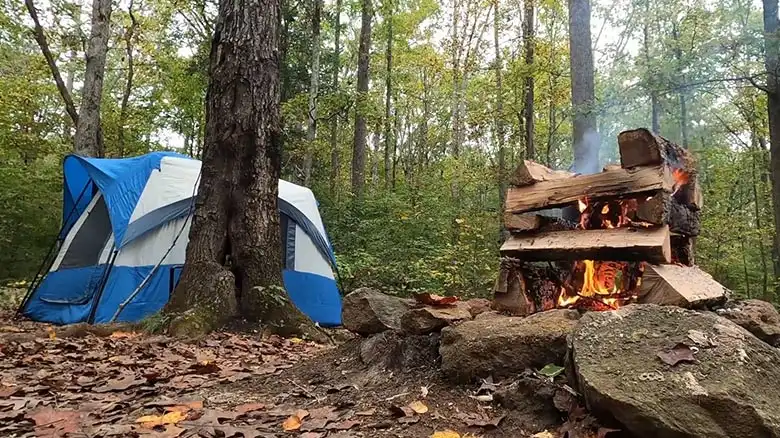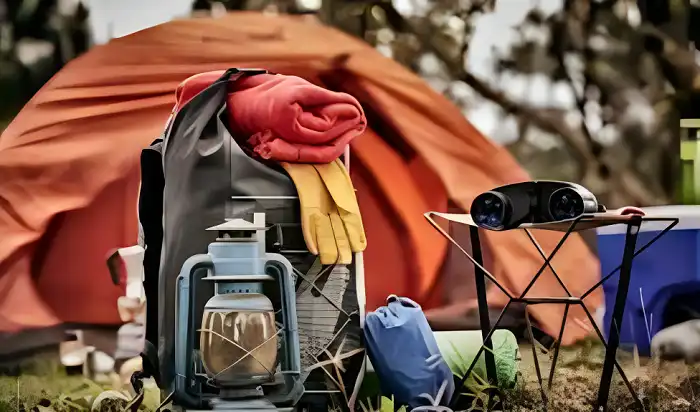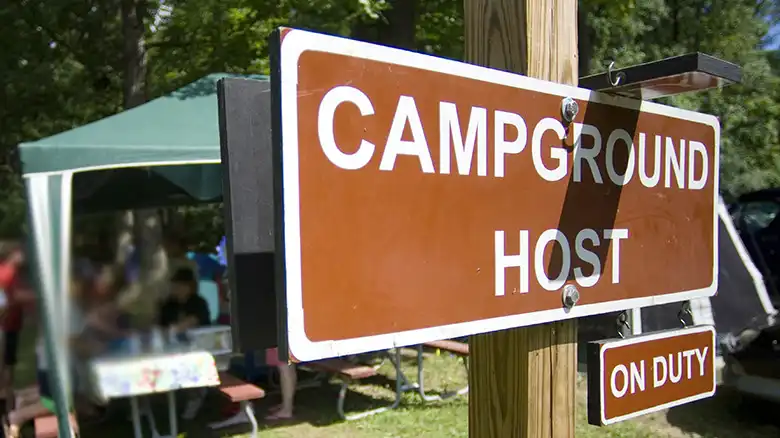Camping is a fun way to enjoy the great outdoors, but it’s important to keep safety in mind, especially when camping with children or large groups. Following some basic campground safety guidelines can help ensure your camping trip goes smoothly. When planning a camping trip, the first step is to choose an appropriate campsite based on your group’s needs and the site conditions.
Consider factors like age ranges, health conditions, or disabilities, select a site that meets accessibility needs, and choose activities suitable for all skill and age levels. Conduct a hazard evaluation by inspecting the site ahead of time to ensure it’s flat and free of dead branches, anthills, poison ivy, etc. Also, check for signs of flooding, erosion, or damp areas that could pose risks.
Proximity to facilities, such as easy access to restrooms, potable water, emergency phones, etc., can be important for some groups. Once you’ve selected an appropriate site, you can start setting up your camp, and it’s vital to organize it safely. Read the entire post to get all the must-have knowledge regarding this topic.

How to Choose the Safest Campsite for Your Group?
When selecting where to pitch your tents and set up camp, safety should be a top priority. Researching the campground ahead of time can reveal important details that inform where your group should stay. Review campground maps, checking for notes about flooding risks, uneven terrain, and overcrowding during peak season. Call ahead to inquire about the site’s accessibility and whether cell reception is available in case of emergencies.

You’ll also want to take careful stock of group members’ ages, mobility levels, medical conditions, and other accessibility needs. For example, if there is an elderly person or someone who uses a wheelchair in your group, avoid campsites only accessible via stairs or with narrow dirt paths. Seek out flat, spacious campsites close to restrooms and water stations. If anyone has severe allergies, choose a site in an area without excessive foliage or plant triggers. Keeping each person’s needs and safety considerations in mind will allow everyone to enjoy the experience.
Key Tips for Setting Up a Safe and Comfortable Camp
After claiming your campsite, setting everything up properly goes a long way toward keeping campers safe, secure, and happy. Be sure to leave adequate spacing between tents, keeping at least 10-15 feet between each shelter. This prevents tripping hazards from guy wires and gives people privacy. It also isolates damage or a collapsed tent in windy conditions.
When placing tents, clear the area of sticks, rocks, pinecones, and other debris that could puncture a tent’s floor. Choose flat, level ground that won’t channel rain runoff toward shelters. Using a broom or leaf blower to remove loose debris is wise. If the ground is wet or uneven, place floor tarps or foldable cots underneath tents to keep campers dry and comfortable.
Be sure to set up cooking and fire areas at least 20 feet away from tents, vehicles, and flammable vegetation like leaves or grass. Designate the area by placing rocks or logs around the periphery and clearing all burnable sticks, pine needles, and brush from within this zone. Keep campfires small and manageable. Always have fire suppression tools like buckets, extinguishers, or dirt/sand nearby in case flames spread.
Essential Campfire Safety Practices Every Camper Should Follow
Campfires often serve as the cheerful centerpiece to a campout, offering warmth and a place to congregate. However, fires can also cause catastrophic damage if basic precautions aren’t followed. Most campgrounds prohibit unattended fires and require flames to be fully extinguished before visitors leave or retire for the evening.
Fire Regulations and Guidelines for Campgrounds
Always check for posted signs or speak to campground staff about specific fire policies. Most prohibit fires during dry seasons or in sites without established fire rings. Adhere to all bans and guidelines to avoid fines or jeopardizing others’ safety.
Safe Campfire Location and Setup Tips
Select an area for a fire building that is at least 15 feet from tents, vehicles, brush, and overhanging branches. Clear a 10-foot diameter circle around the pit from dry leaves, grass, pine needles, and other quick-burning debris. Construct a fire ring by enclosing the area with medium-sized rocks, gravel, or other non-flammable materials if one is not already present.
How to Properly Monitor and Extinguish Your Campfire
Fires must be monitored at all times by at least one sober, awake adult until completely extinguished. Never leave a blaze unattended, even for a few minutes. Accidents happen quickly, so always keep fire suppression tools nearby. Have a bucket of water, loose soil, sand, or a fire extinguisher on hand to douse unexpected flames.
Extinguish Thoroughly
Burn fires down completely to ash and embers before trying to extinguish them, as dousing logs can create hazardous smoldering. Drown embers fully by stirring, separating, and saturating with water. Check by placing your hand close to the ashes to feel for heat. Repeat as needed until fully cold.
Storing Food Securely to Avoid Wildlife Encounters
Proper food storage is key for keeping campsites safe from unwanted wildlife visitors. Certain campgrounds mandate the use of bear-proof canisters to prevent bears from accessing tasty treats. Yet even in sites without bear activity, locking up food deters opportunistic raccoons, rodents, and other wildlife from wandering through camp seeking snacks.
Follow posted guidance about securing edibles in bear lockers or out-of-reach hanging bags suspended between trees. Even if not officially required, it’s wise to store all scented items like toothpaste, lotions, and fragrant soap with food instead of in tents or cars. Never keep any food, even snacks or beverages, inside shelters where smells can attract curious animals that could damage tents.
After preparing or eating meals, thoroughly clean up food scraps, rinse dishes well, and securely store all items immediately afterward. Following these best practices will help ensure animals don’t interrupt restful sleep-seeking crumbs in camp!
Best Practices for Staying Safe Around Wildlife While Camping
Learning how to safely share natural spaces with wildlife is an essential skill for campers. Research which animals populate the area you’ll be visiting, familiarizing yourself with large mammal behaviors as well as smaller creatures that could transmit diseases.
While many animals avoid human interaction, some may be drawn to food odors and refuse. Carefully storing edibles and properly disposing of garbage greatly minimize risky encounters. Never feed wild animals, both for health reasons and conditioning them to equate humans with food rewards.
If a large mammal approaches while hiking or in camp, remain calm. Avoid sudden movements, instead stand still and give them space to pass. Talk in a normal voice to signal human presence, and slowly back away if they linger. Most will retreat once detected unless defending young or a food cache.
Regarding smaller animals, do not touch or handle any wildlife, dead or alive, to avoid potential bites or pathogen transmission. Discourage squirrels, mice, and birds from approaching too closely by keeping sites clean. Seek medical care promptly if bitten or scratched. While not advised, keeping the rabies vaccine current when spending much time outdoors is protective.
Ensuring Children’s Safety in the Campsite
Camping with kids requires some special safety planning, as their natural curiosity and developing coordination can lead to dangerous situations. Establish clear physical boundaries for where children can freely explore around the campsite. Ensure they understand landmarks denoting play area limits. Younger children and non-swimmers should always be watched carefully when near water.
Assign an adult to supervise anytime flames, stoves or hot surfaces are in use during cooking tasks and campfire building/extinguishing. Likewise, an adult should dispense fuels like charcoal lighter or propane and directly tend to lit flames, as these can be extremely hazardous for children. Consider letting older kids participate by having designated “fire tenders” who monitor the blaze under adult guidance.
Take time to teach young campers about tool and fire safety. For example, sharp knives and axes should only be wielded under adult supervision. Make clear that fires or hot stoves can badly burn those who get too close. Have kids practice “freeze” during fire drills where they immediately stop moving if you call out. This can prevent dangerous accidents.
Make sure children keep footwear on around camp, especially near fires that may have hot embers or sharp twigs. Durable water shoes, closed-toe sports sandals, or lightweight hiking shoes work well for active play while protecting vulnerable feet. Pack whistles or walkie-talkies for children to alert adults if in distress or lost. Establish emergency procedures for scenarios like an injured or missing child.
Discuss expectations for safe conduct around wildlife before encountering animals. Children must understand not to approach, feed, or chase wild creatures that could bite or transmit disease. Review what to do if one is spotted near the camp, having kids practice freezing in place or calmly backing away. High-energy games like tag should occur in designated areas away from cooking spaces to avoid collisions.
Staying hydrated and refueling with regular, balanced meals and healthy snacks keeps kids’ blood sugar stable, minimizing fussiness and irrational behavior. Have nourishing grab-and-go foods on hand for between-meal hunger like mixed nuts, fresh or dried fruit, carrot sticks, and turkey jerky. These keep kids satisfied and avoid crankiness or impulsive poor choices that could put them in harm’s way. Assign age-appropriate chores like trash pickup or wiping down picnic tables to make children feel included while also expending pent-up energy.
First Aid and Emergency Preparedness for Campers
Despite best efforts at caution, accidents and injuries can happen while camping. From minor cuts and blisters to more serious concerns like burns, fractures, or allergic reactions from plants or insect bites, having first aid knowledge and supplies on hand is invaluable until professional medical treatment can be reached. Prepare by:
Assembling a First Aid Kit – Pack a clearly labeled, waterproof container with ample wound care supplies like bandages, gauze pads, adhesive tape, antiseptic wipes, and ointments. Also include medications for pain, stomach issues, respiratory symptoms, and allergic reactions if these conditions could arise. Personalize content for specific medical needs within your group.
Learning First Aid Techniques – Take a reputable first aid course to familiarize yourself with assessing injuries, proper wound care, applying splints and slings, and more. Supplementary wilderness-specific training adds familiarity with injuries and illnesses common in remote settings. Know how to recognize signs of heat stroke, hypothermia, dehydration, and anaphylaxis as these can be life-threatening if not addressed quickly.
Understanding Emergency Procedures – Before embarking, know how to contact emergency responders from the campsite, provide accurate coordinates to direct crews to your location, and indicate landmarks to describe when help might arrive. Understand contingency protocols for evacuating the area safely.
Staying Informed – Monitor extended weather forecasts for storms that could prompt flash flooding, lightning strikes, etc. Heed posted warnings about ongoing hazards like mosquito-borne illnesses or temporary site closures. Suspend activities immediately if informed of an imminent threat like a wildfire encroaching on the area. Never hesitate to ask campground staff questions or voice concerns about site safety while staying.
The Importance of Following Campground Rules
In addition to following the safety guidelines already outlined, it’s important to adhere to campground regulations to protect the environment and have consideration for other visitors. Ignoring posted rules could incur fines or even ejection from public lands.
Most campsites mandate that quiet hours be observed after 10 pm, limiting loud noises that could disturb neighboring campers’ rest. Always be conscientious of noise volume from radios, chatter, vehicle doors slamming, etc. Shouting or fireworks are almost always prohibited.
Similarly, adhering to posted check-in/check-out times maintains order when different groups occupy the same site on consecutive days. Make sure you vacate by the established deadline to give the next party proper time to move in.
Most public lands forbid cutting vegetation or defacing natural features. While collecting firewood from downed branches is often allowed, confirm what’s permitted versus prohibited. Follow all posted instructions to minimize your impact on trails and water sources when bathing/procuring drinking water. Utilize established restrooms and trash facilities to avoid contamination.
Overall, embracing Leave No Trace principles for properly disposing of waste, respecting wildlife, and practicing minimum impact camping ethics keeps campgrounds safe, sanitary, and enjoyable for all.
Conclusion
Camping delivers immense enjoyment of fresh air, natural beauty, and quality time with loved ones. Keeping health and welfare top of mind by secure food storage, fire safety, first aid readiness, and site selection allows everyone to relish the experience fully. Familiarizing yourself with campground regulations and practicing conscientious environmental stewardship ensures the privilege of appreciating these public spaces for future generations. Follow basic safety guidelines and common sense to create treasured memories!
FAQs
Is it safe for kids to have their own tent?
Letting school-age children sleep solo in their own tent builds confidence and independence, as long as responsible adults occupy adjacent tents within direct earshot and sightlines. Establish emergency procedures like providing flashlights and whistles so kids can signal adults if scared at night or needing assistance exiting their tent. Set expectations for tent behavior and make sure children understand not to keep food inside shelters.
Is it safe for pets to come camping too or should they stay home?
Before bringing pets camping, assess if dogs/cats are allowed in the first place, can remain leashed when outside tents per regulations, and are not likely to excessively disturb local wildlife with barking or wandering. Also, make sure you are prepared to pack out all pet waste. Unattended dogs and cats can negatively impact habitats by rummaging through belongings, antagonizing large mammals when off-leash, or leading bears back to tents in some cases. Weigh the pros and cons before assuming pets can come.
With kids, how can I gently discourage bold wildlife from approaching our campsite?
Take proactive steps to secure all human and pet food, trash, and scented items securely out of reach of opportunistic wildlife. Make loud disruptive noises, toss small objects, or spray water to gently discourage squirrels, birds, and similar small animals from approaching your campsite. Persistent larger mammals like foxes, make noise and contact the campground host or park rangers to remove the creature humanely. Carefully supervise young children at all times outdoors, placing yourselves between wildlife and kids while backing everyone slowly to safety if necessary.


